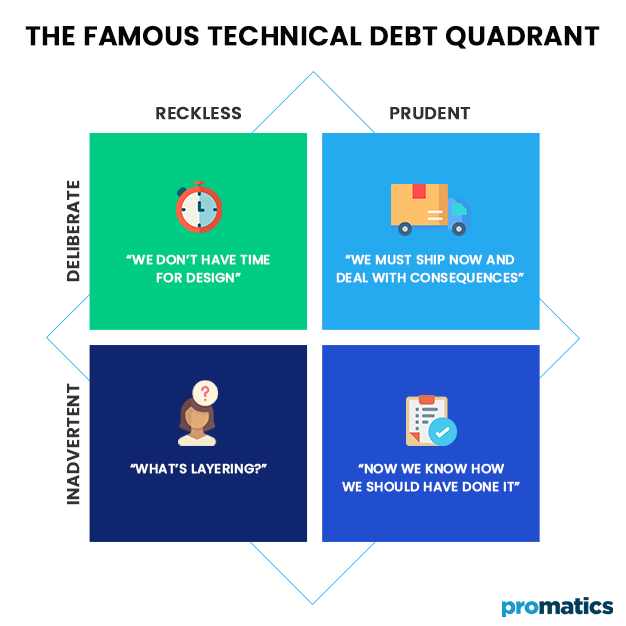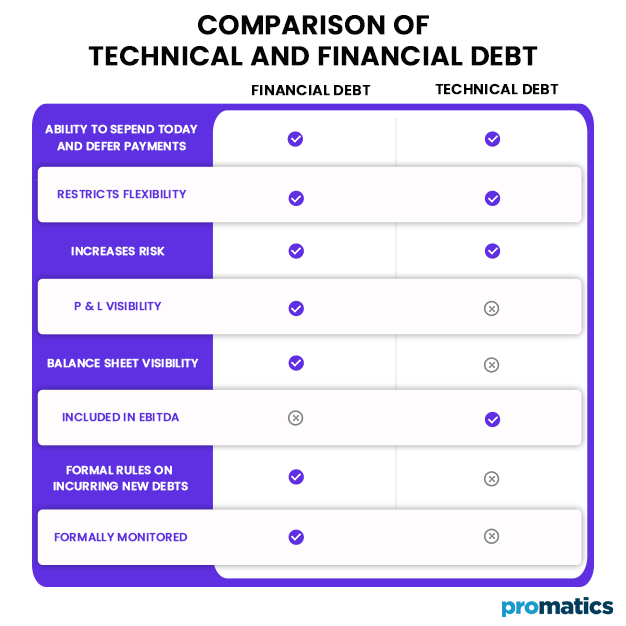Technical Debt and its Implications
With time, the world depends more and more on technology, computers, phones, and applications. An increased dependency puts extra pressure on software companies, coders, and developers to minimize flaws and reduce errors to almost none, if not wholly none. One of the biggest threats to a software firm is technical debts, so it should be a primary concern for all technical developers to deal with it and avoid it. Once you go through this article, you will have sufficient knowledge about technical debt, its types, causes, implications, and tactics to reduce and remove it.
What is Technical Debt:
If you have come across the term “technical debt” for the first time, here is an analogy that will best help you answer the question of what technical debt is.
Imagine that you are about to open a burger joint. You do not have adequate staff to manage things at the back end in the kitchen, but your marketing team has created enough hype that you can not delay the opening. You also assume that you will be able to manage things easily in the kitchen, or you are unaware that they will affect or mess up your orders. On the grand opening, you have a houseful, and things start to get disorganized in the kitchen. The staff considers preparing the burgers a priority in the minimum amount of time and ignores organizing the pantry. Consequently, the unwashed dishes start to pile up in the sink, the countertops become crowded with cutting boards, knives, and crumbs, cluttering the entire kitchen.
The accumulated mess is the technical debt in this scenario. While developing an application or software, the software house or company may face a deadline or financial issues and release a somewhat faulty product with problems in its source code. So, the company does a technical trade-off to hasten the delivery process at the cost of the code’s quality. You decided to take a short-term solution by preparing the burgers on time but ignored its long-term consequences. Or you released your application without integrating the system correctly.
Ward Cunningham, a great programmer and software developer, first used the term technical debt. He knew it was a complex phenomenon to describe, so he related it to financial debt. You may have bought a car today (released the software), but you still have to pay your friend from whom you took the loan tomorrow (do the coding and correct the errors).
Like financial debt, technical debt, or as others call it, tech debt or code debt, can also incur interest. But, we will discuss that in detail while talking about the implications of technical debt.
Causes:
Software houses and companies can become a victim of technical debt due to various reasons, some of which are:
1.) Financial issues:
Remember the analogy that we just used? You did not have enough budget to hire separate people for doing the dishes and organizing the kitchen as the waiters prepare the orders, instead of after preparing them. Similarly, a company might not have enough expenses to keep the project running and correct the imperfect code, also called cruft, as the development work is pretty expensive. You will see this mainly in growing companies that survive off the profit from shipping and releasing orders, so they have a critical need to do it early.
2.) An impending deadline:
How often have we seen great ideas not executed to perfection because of an impending deadline, even in our everyday lives? The developer might have to choose between the quality of the code and speedy delivery, and more often than not, the developers choose the former. The coders move too fast to make the deadline and take shortcuts, resulting in technical debt in the code, documentation, or simply poor project management.
3.) Unidentified errors:
Another prevalent cause of technical debt is hidden mistakes and unidentified errors distinguished chiefly by customer and user reviews. Before releasing the original version, the developers release a beta version of the new android update for specific phones. Earlier, it used to be the Nexus series but now, the Pixel series enjoys this advantage. Even after removing the faults successfully, the released android version still has bugs discovered later by users and debugged with subsequent updates. Similarly, other software, games, and applications are updated repeatedly to remove bugs and fix issues not identified during the developmental period.
Types:
Several people took it up to them to devise a system that best explains the types of technical debt.
In 2007, Steve McConnel divided technical debt into two types:
a.) Intentional technical debt:
Sometimes, the coders know that there is room for improvement in the code. However, they still deliberately submit the project, resulting in a deliberate technical debt or intentional technical debt. The developers use this type of technical debt as a strategic tool to reduce the time to deliver the product to the market. A looming deadline for the submission can also cause an intentional technical debt.
b.) Unintentional technical debt:
Unintentional technical debt is, in simple words, a job done poorly. Unlike intentional technical debt, it is not a strategic tool and often haunts the developer. If the developers are working on a relatively new coding technique, the chances of an unintentional technical debt are very high.
Sadly, this system of dividing technical debt into types was insufficient. The academic paper Towards an Ontology of Technical Debt provided the world of software and technology with a better system. This system divides technical debt into 13 types, which are:
i.) Architecture Debt
ii.) Build Debt
iii.) Code Debt
iv.) Defect Debt
v.) Design Debt
vi.) Documentation Debt
viii.) Infrastructure Debt
ix.) People Debt
x.) Process Debt
xi.) Requirement Debt
xii.) Service Debt
xiii.) Test Automation Debt
xiv.) Test Debt
The third way of categorizing and dividing technical debt is the most accurate and widely used of all and goes by the name “Martin Fowler’s Technical Debt Quadrant.” Martin Fowler first categorized technical debt based on the developer’s intent, like Steve McConnel’s system, and then by the recklessness of the debt, whether it is prudent or reckless. Hence, after inspection, you can deduce whether your technical debt is Reckless and Deliberate, Prudent and Deliberate, Reckless and Inadvertent, or Prudent and Inadvertent.
Implications:
Technical debt is a red flag for any software-related project and a nightmare, even for the most prominent software companies. And the worst thing is, each implication continuously keeps making things worse for the company or firm until the developers do not amend the mistakes and deal with the technical debt. For this reason, this debt, like financial debt, also has an interest incurred on it with time. But this is not the case all the time. Sometimes, technical debt may not be as bad as it seems. Hence, developers can correct it after some adjustments and few revisions. Based on the intensity of error in the code or documentation, technical debt can have several implications. Some of these are:
a.) Financial setbacks:
The most harmful and common implication of technical debt is the financial setback it causes to the company. Not being error-free, the product fails to attract potential customers and users, so the company can not enjoy a profit from sales. Moreover, they keep the project running until they debug code, leading to additional expenses that can cripple the company and cause serious setbacks. If there is a security breach, the company might have to pay a fine as well. Various companies have even gone bankrupt because they did not resolve the high technical debts timely.
b.) Time wastage:
Wastage of productive time is one of the interests incurred on a software company because of technical debts. Instead of starting a new project, the developers and coders are stuck making amendments to the previous project. Hence, technical deficits hamper productive forward motion and growth of the company. Sometimes, there are so many mistakes in the code that the company has to start the project once again. A company developed an enterprise-level iOS app in over a year, but it faced failed Apple submissions. When they brought in AIM Consulting to check the issue, the code had several faults that they could not debug, and as a result, the company had to scrap everything and start from scratch.
c.) Poor customer reviews:
If someone is paying for an app or software, they expect it to run smoothly and without bugs. But, if that is not the case and they do not get their money’s worth, you will have one angry customer who is very dissatisfied with your work. There is a lot of competition in the market, and if your company is not giving an up-to-the-mark performance, your client might even switch to another software firm. If you are developing a game or mobile app, users will give it a poor rating and reviews on Play Store or App Store if there are problems in the code. Having good user reviews can go a long way if you are a growing company and have a significant impact.
Remedies:
Now that we know all the essential stuff regarding technical debts and their implications, here are some tactics that can help address the situation:
a.) Eliminate the source:
As always, the best way to deal with a problem is by eliminating the source. Look into the bugs and issues in the code, and instead of ignoring them and focusing on new features, debug the code and rework the software.
You must have come across the very famous proverb, “a stitch in time saves nine.” Now, it is time to act on it as well. You can remove the cruft by several methods. The most widely accepted scheme is a 6-step process in which the developers first inventory and categorize the cruft, and then appraise it. Afterward, they air the mediocre code by making the list of errors visible to everyone. Finally, make space for the redundant code and remove it regularly. These six steps will ensure the cruft does not bother you.
An additional tip: When you are amending the code, do not try and do all of it in one go, as rushing things might be causing the debt initially. Do the debugging one session at a time.
b.) Open source code:
Various companies and organizations look towards open source communities whenever they find themselves facing a technical debt. You can get reusable frameworks from public GitHub or other public repositories where people have posted solutions to almost all the possible problems.
A helpful tip: While looking for an open-source code, make sure you use the one that is either recently posted or updated. Using an old code can make things even more complicated for you and your team.
Conclusion:
Technical debt is bad for business. It can break your bank, pile up the workload, and get you bad reviews from clients and customers. Hence, it is best to deal with mediocre code and cruft regularly and avoid technical debts at all costs.
Still have your concerns?
Your concerns are legit, and we know how to deal with them. Hook us up for a discussion, no strings attached, and we will show how we can add value to your operations!



